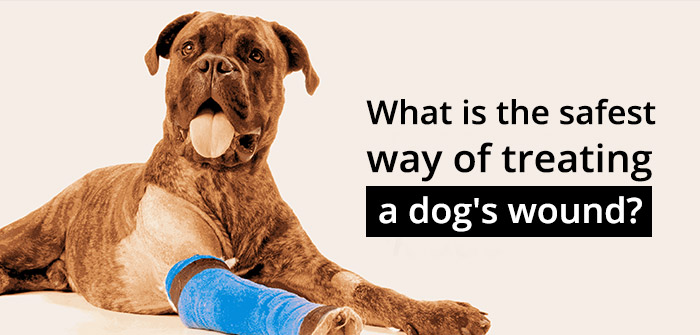Find the Right Wound Care Products: Safest Way to Treat & Heal Dog’s Wound

Let’s say your dog gets himself into a little mischief and suffers a serious injury. Thankfully, the veterinarian will quickly and effectively treat them, and voilà, your dog is back to being healthy!
Isn’t it so simple?
Not so easy, my friend. Unfortunately, it will take time and you need to be careful before your dog’s injury heals completely and returns to normal. Any wound goes through four stages of healing:
- Inflammation
- Infected skin
- Repair
- Maturation
What can I do to treat an open wound on my dog at home?
You will need to take extra care while treating pets. Humans and dogs react differently to injuries. While humans understand the scenario of how to take care, dogs don’t. Hence, here are some general care guidelines you can understand:
- It’s important to gently clean the wound and its surrounding area to remove any sticky residue. This will keep the wound edges clean, reduce the risk of re-infection, and allow the growth of new healthy tissue.
- Follow the instructions for taking all of your drugs. If your veterinarian has ordered you to stop giving your dog antibiotics for some reason, follow his or her instructions.
- Do not encourage your dog to lick or chew on the open wound.
- To avoid injuring the skin further, get your dog a protective collar.
- It’s important to keep the skin from healing too rapidly around the wound. This is particularly important for abscesses that have been surgically lanced and drained. The risk of recurrence increases if the wound closes prematurely.
What can you put on dog wounds?
Two of the most important aspects of home care are gently cleaning the wounds and applying Dermaclens for Dogs a couple of times to it. Keep a close eye on the wound for signs of infection, such as persistent redness, swelling, or purulent discharge. Contact your veterinarian in case of infections.
What antiseptic can I use on my dog?
Derma-Vet is used to treat cutaneous diseases in dogs and cats, such as those affecting the skin, hair, nails, and associated muscles and glands. This ointment is particularly effective for infections caused or worsened by bacteria and yeast.
What is the best way to treat a dog’s open wound?
- Clean the surrounding area of wound
Apply a water lubricant first before cutting the hair near the wound with a razor, electric clipper, or scissors. Shaving the hair around the wound makes it easier to clean the wound on a daily basis.
- Add some antiseptic
After shaving your dog’s fur, use a dry cloth to clean away any residual lubricant or hair, and then add your preferred antiseptic.
- Apply some antimicrobial treatment
It’s good to use an antimicrobial treatment in addition to an antiseptic on your dog’s wound, especially those containing Povidone-iodine. Wound Gard for Dogs is a good option because it fights bacteria with antiseptic and expectorant ingredients, and it’s easy to use. You won’t have to worry about your dog licking the treatment off as much.
You can also use a topical solution like Avert Bitter Solution for Dogs is an excellent bitterant that controls biting and chewing behavior in pets. It is extremely bitter and is used on bandages and dressings, as well as on open wounds. The spray solution prevents chewing, licking, and biting wounds and stitches.
How can I help my dog’s wound heal faster naturally?
- Use skin-soothing herbal teas or a herb-vinegar rinse to clean the cuts or wounds.
- Use skin-healing hydrosols, essential oil blends, or other topical items to encourage cell growth, combat infection, and hasten the healing process.
- Continue to offer your dog vitamins and other natural healing nutrients on a regular basis to assist in the healing of deep wounds.
What causes open wounds on dogs?
Open wounds in dogs can be caused by a variety of factors. When the superficial skin layers are scraped, abrasions may occur. This can result in mild inflammation, some bleeding on the surface, and possibly bruising.
Lacerations occur when the skin of your dog is cut or ripped open.
Puncture wounds, also known as bite wounds, occur when an object or a tooth pierces the skin and leaves a small opening. The hole is likely to impact several layers of tissue and is especially vulnerable to bacterial infections. Puncture wounds can quickly become infected, resulting in a more severe medical situation for your dog.
Should I let my dog lick his wound?
Although licking wounds can provide defense against some bacteria, there are also serious disadvantages to allowing your dog to lick them. Excessive licking can irritate the skin, resulting in hotspots, infections, and the possibility of self-mutilation.
Final words:
In order to treat dog wounds properly:
- Administer all treatments as directed.
- Gently clean the wounds with salt water.
- Use an E-collar to keep the dog from licking the wounds.

GET TO KNOW MORE:
Minor Injuries In Dogs – Step By Step Guide To Tend The Wounds
Knowledge is meant to be Shared

